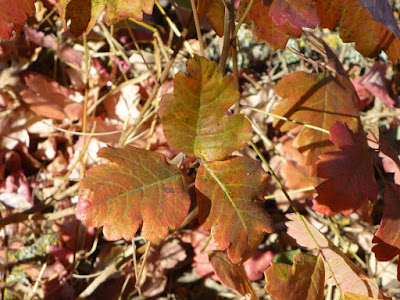 |
| A sycamore with a view: Hobbit Tree peekhole |
Sycamore Grove Park is
a small semi-urban park surrounded by neighborhoods, wineries and orchards. The
ruins of the old Olivina Winery can be found within this open-space park with its many
loop trails. Hiking, bicycling and horseback riding trails traverse sycamore and oak woodland as well as grasslands. Unpaved roads and single-track paths over hilly landscape offer varying vistas of the valleys and mountains of the
Diablo Range, including the
Mt. Diablo Summit and
North Peak north of Livermore. If you enjoy relaxing in riparian habitat, you may just want to stroll along the trails on either side of the willow-lined
Arroyo del Valle, which runs through the park.
 |
| Sycamore bark patchwork |
The park is named for California's native
western sycamore trees that you can explore on the brookside plains.
Platanus racemosa (family
Platanaceae) trees grow over 100 feet (35 m) tall. Trunks commonly divide in two or more strong trunks. The bark typically builds a patchwork of white, gray and beige layers. Older and darker bark slowly peels away.
 |
| Arroyo del Valle seen from Magpie Loop Trail |
The
Hobbit Tree, a hollow tree with a look-through hole, is the most popular sycamore in the park and a fun site for photo shoots. Sylvia Linsteadt explains that western sycamore trees can live for hundreds of years and that the oldest tree sprouted in what is now Sycamore Grove Park some 300 years ago [1]. Describing the grand old sycamores amid flat grassland on either side of the Arroyo del Valle streambed, she writes about the once common, now rare
sycamore alluvial woodlands in California:
Such wide, graveled banks are a classic feature of sycamore alluvial woodland, and they're integral to the tree's health and longevity. A distinct and vital ecosystem in California, sycamore alluvial woodland is characterized by summer-dry streambeds that branch and braid out through the sandbars, silt, and gravel beds deposited by winter rains and floods. [...]. Livermoore's Sycamore Grove Park is among the few preserved alluvial woodlands left in the East Bay, and as such it provides us a window into an older California.
The flooding that occurred during the 2016/2017 winter rains hopefully boosted the revival and healthy growth of those sycamores that had been damaged in drought years.
Getting there
Sycamore Grove Park has two main entrances (a few miles south from downtown Livermore): the
Wetmore Road entrance at the park's northwest end and the
Arroyo Road entrance at the southeast side, not very far from the Del Valle Regional Park entrance.
 |
| Wetmore Road Entrance |
To get to the
Wetmore entrance, drive west (best on 1st Street) from downtown Livermore to get on
Holmes Street. The latter takes you south and continues as
Vallecitos Road. Turn left on
Wetmore Road and, after 0.3 miles, find the park entrance to your right.
To get to the
Arroyo entrance, drive south on
S L Street from downtown Livermore. S L Street continues as
Arroyo Road. After passing the Arroyo Road/Wetmore Road junction with the historic
Olivina Gate, follow Arroyo Road for another 1.5 miles and find the park entrance and
ranger station to your right across the
Wente Vineyards.
References and more to explore
[1] Sylvia V. Linsteadt:
Western sycamores speak of an older California.
Bay Nature Oct. - Dec.
2017, 16-20+52. Link:
baynature.org/article/western-sycamores-speak-older-california.
[2]
Livermore Area Recreation & Park District:
www.larpd.org/open_space/sycamore.html.

































































